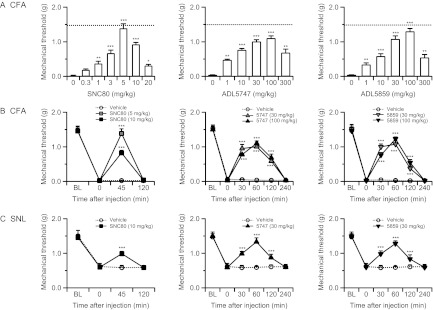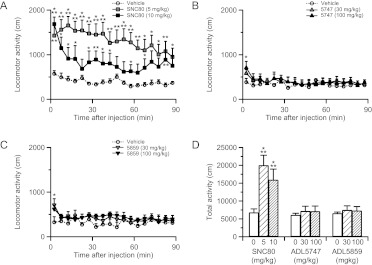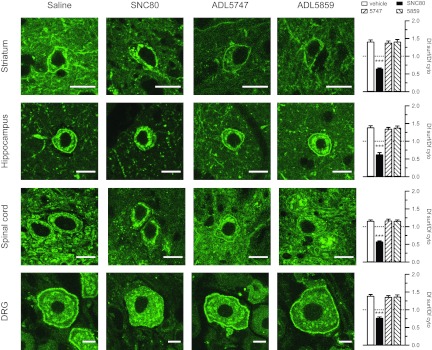
| Size | Price | Stock | Qty |
|---|---|---|---|
| 5mg |
|
||
| 10mg |
|
||
| 25mg |
|
||
| 50mg |
|
||
| 100mg |
|
||
| 250mg |
|
||
| Other Sizes |
|
Purity: ≥98%
ADL5859 HCl (ADL 5859; ADL-5859), the hydrochloride salt of ADL5859, is a potent, orally bioavailable δ-opioid receptor agonist with important biological activity. It has a Ki of 0.8 nM for δ-opioid receptor activation. ADL5859 demonstrated selectivity towards alternative opioid receptors, including κ and μ.
| Targets |
δ Opioid Receptor/DOR
|
||
|---|---|---|---|
| ln Vitro |
|
||
| ln Vivo |
|
||
| Animal Protocol |
|
||
| References |
|
| Molecular Formula |
C24H29CLN2O3
|
|
|---|---|---|
| Molecular Weight |
428.95
|
|
| Exact Mass |
428.19
|
|
| Elemental Analysis |
C, 67.20; H, 6.81; Cl, 8.26; N, 6.53; O, 11.19
|
|
| CAS # |
850173-95-4
|
|
| Related CAS # |
850305-06-5 (ADL 5859 free base)
|
|
| Appearance |
Solid powder
|
|
| SMILES |
CCN(CC)C(=O)C1=CC=C(C=C1)C2=CC3(CCNCC3)OC4=CC=CC(=C42)O.Cl
|
|
| InChi Key |
ZFNLSWREIULTDO-UHFFFAOYSA-N
|
|
| InChi Code |
InChI=1S/C24H28N2O3.ClH/c1-3-26(4-2)23(28)18-10-8-17(9-11-18)19-16-24(12-14-25-15-13-24)29-21-7-5-6-20(27)22(19)21;/h5-11,16,25,27H,3-4,12-15H2,1-2H3;1H
|
|
| Chemical Name |
N,N-diethyl-4-(5-hydroxyspiro[chromene-2,4'-piperidine]-4-yl)benzamide;hydrochloride
|
|
| Synonyms |
|
|
| HS Tariff Code |
2934.99.9001
|
|
| Storage |
Powder -20°C 3 years 4°C 2 years In solvent -80°C 6 months -20°C 1 month Note: Please store this product in a sealed and protected environment, avoid exposure to moisture. |
|
| Shipping Condition |
Room temperature (This product is stable at ambient temperature for a few days during ordinary shipping and time spent in Customs)
|
| Solubility (In Vitro) |
|
|||
|---|---|---|---|---|
| Solubility (In Vivo) |
Solubility in Formulation 1: ≥ 2.75 mg/mL (6.41 mM) (saturation unknown) in 10% DMSO + 40% PEG300 + 5% Tween80 + 45% Saline (add these co-solvents sequentially from left to right, and one by one), clear solution.
For example, if 1 mL of working solution is to be prepared, you can add 100 μL of 27.5 mg/mL clear DMSO stock solution to 400 μL PEG300 and mix evenly; then add 50 μL Tween-80 to the above solution and mix evenly; then add 450 μL normal saline to adjust the volume to 1 mL. Preparation of saline: Dissolve 0.9 g of sodium chloride in 100 mL ddH₂ O to obtain a clear solution. Solubility in Formulation 2: ≥ 2.75 mg/mL (6.41 mM) (saturation unknown) in 10% DMSO + 90% (20% SBE-β-CD in Saline) (add these co-solvents sequentially from left to right, and one by one), clear solution. For example, if 1 mL of working solution is to be prepared, you can add 100 μL of 27.5 mg/mL clear DMSO stock solution to 900 μL of 20% SBE-β-CD physiological saline solution and mix evenly. Preparation of 20% SBE-β-CD in Saline (4°C,1 week): Dissolve 2 g SBE-β-CD in 10 mL saline to obtain a clear solution. View More
Solubility in Formulation 3: 0.5% hydroxyethyl cellulose+0.1% Tween 80: 30 mg/mL |
| Preparing Stock Solutions | 1 mg | 5 mg | 10 mg | |
| 1 mM | 2.3313 mL | 11.6564 mL | 23.3127 mL | |
| 5 mM | 0.4663 mL | 2.3313 mL | 4.6625 mL | |
| 10 mM | 0.2331 mL | 1.1656 mL | 2.3313 mL |
*Note: Please select an appropriate solvent for the preparation of stock solution based on your experiment needs. For most products, DMSO can be used for preparing stock solutions (e.g. 5 mM, 10 mM, or 20 mM concentration); some products with high aqueous solubility may be dissolved in water directly. Solubility information is available at the above Solubility Data section. Once the stock solution is prepared, aliquot it to routine usage volumes and store at -20°C or -80°C. Avoid repeated freeze and thaw cycles.
Calculation results
Working concentration: mg/mL;
Method for preparing DMSO stock solution: mg drug pre-dissolved in μL DMSO (stock solution concentration mg/mL). Please contact us first if the concentration exceeds the DMSO solubility of the batch of drug.
Method for preparing in vivo formulation::Take μL DMSO stock solution, next add μL PEG300, mix and clarify, next addμL Tween 80, mix and clarify, next add μL ddH2O,mix and clarify.
(1) Please be sure that the solution is clear before the addition of next solvent. Dissolution methods like vortex, ultrasound or warming and heat may be used to aid dissolving.
(2) Be sure to add the solvent(s) in order.
| NCT Number | Recruitment | interventions | Conditions | Sponsor/Collaborators | Start Date | Phases |
| NCT00603265 | Completed | Drug: ADL5859 Drug: Duloxetine |
Peripheral Neuropathy Neuropathic Pain |
Cubist Pharmaceuticals LLC, a subsidiary of Merck & Co., Inc. (Rahway, New Jersey USA) |
November 2007 | Phase 2 |
 |
|---|
 |
 |